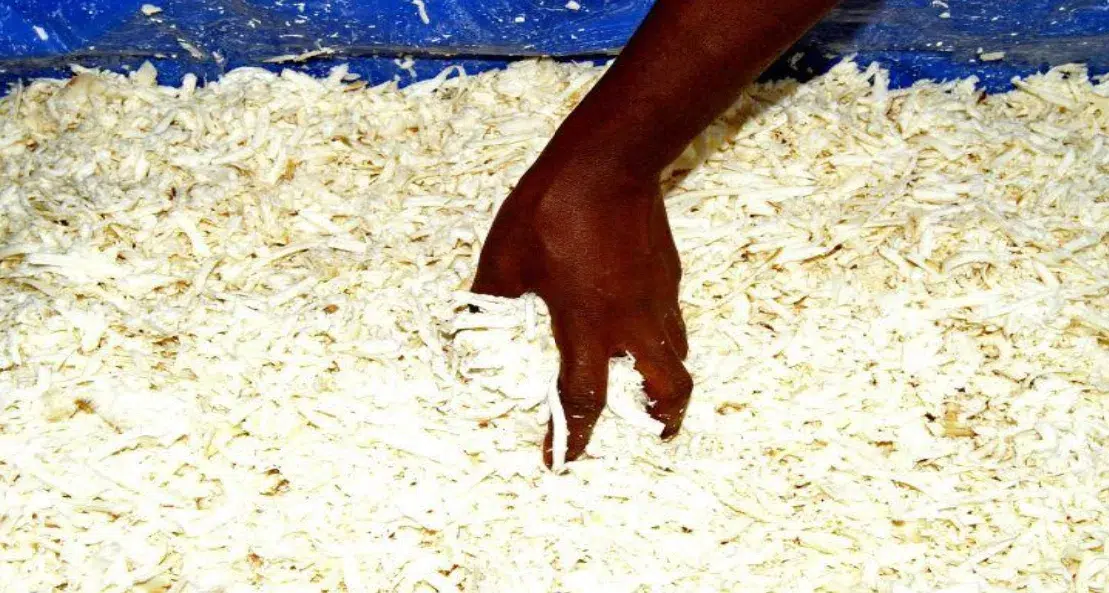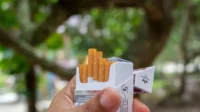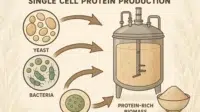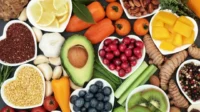Introduction: A Chewy Journey from Root to Snack
Imagine biting into a piece of dried cassava firm yet chewy, with a mild sweetness that lingers on your tongue.
Unlike its fresh counterpart, which must be carefully processed to avoid toxicity, this snack can last for months without refrigeration.
But how does a potentially dangerous root become a safe, nutritious food? The answer lies in the power of heat and time during the drying process.
Cassava (Manihot esculenta Crantz), often called the “tropical bread,” is a staple crop across Africa, Asia, and Latin America.
In Indonesia, especially around Bogor, cassava plays a vital role in both local diets and agro-industrial production.
However, cassava naturally contains cyanogenic glycosides, compounds that can release toxic hydrogen cyanide if not properly removed through processing.
Drying is more than just removing water it’s a critical step that reduces cyanide levels and enhances shelf life.
But not all drying methods are equal. The temperature used during drying makes all the difference between a safe, tasty product and one that poses health risks.
Baca Juga: Sains Dibalik Cerahnya Rebusan Daun Singkong ala Rumah Makan Padang, Hanya dengan Soda Kue!
In this article, we explore how drying at different temperatures transforms cassava from a potentially toxic tuber into a nutrient-dense, long-lasting food.
We examine the biochemical changes that occur during dehydration, the various drying techniques employed today, and their implications for nutrition, economics, and sustainability especially in small-scale communities around Bogor, West Java.
Why Drying Matters in Cassava Processing
Fresh cassava roots contain linamarin and lotaustralin, two natural compounds that can break down into hydrogen cyanide when exposed to enzymes in the plant or human digestive system.
Consuming improperly processed cassava has been linked to chronic conditions like konzo, a neurological disorder caused by long-term cyanide exposure (Montagnes, 2021).
This is where drying comes in. By exposing sliced cassava to heat over time, moisture is removed, and cyanide is volatilized meaning it evaporates into the air.
Higher drying temperatures speed up this detoxification process, making the final product safer for consumption. But drying isn’t just about safety. It also:
- Extends shelf life, reducing spoilage and losses.
- Enhances flavor concentration, giving dried cassava a unique taste.
- Improves transportability, allowing products to reach distant markets.
- Supports smallholder farming communities, especially in rural Indonesia.
In places like Bogor, where cassava is widely grown and processed, understanding the best drying techniques is key to supporting food security, economic development, and public health.
Baca Juga: Potensi Singkong sebagai Solusi Lokal
How Drying Temperature Changes Everything
Scientific studies show that drying temperature significantly influences cyanide reduction in cassava.
The higher the temperature, the faster the breakdown of cyanogenic glycosides the compounds responsible for releasing hydrogen cyanide (Njoku et al., 2020; Agbemafle et al., 2021).
For example:
- At 50°C, drying may take up to 12 hours , and cyanide levels remain above recommended safety thresholds.
- At 60°C, detoxification improves, with most samples reaching acceptable limits after 8–10 hours .
- At 70°C, total cyanide levels drop below 10 mg/kg the international safety limit set by the FAO/WHO in as little as 6 hours.
The reason? Heat accelerates the breakdown of linamarin and lotaustralin while promoting the escape of volatile hydrogen cyanide.
Additionally, higher temperatures deactivate residual enzymes like β-glucosidase, which catalyze cyanide release during storage (Jayaraman & Das Gupta, 2021).
However, there’s a balance. Too much heat can cause undesirable changes in texture and starch structure.
That’s why researchers recommend 60–70°C as the optimal range for drying cassava safely and preserving its functional qualities (Azizah et al., 2020; Khan et al., 2022).
Baca Juga: Deforestasi di Indonesia: Masalah Serius yang Harus Kita Perhatikan Bersama
Real-World Applications in Bogor and Beyond
In Bogor, many small-scale processors still rely on sun drying, which can be slow and inconsistent due to weather variations.
Some are adopting hot air dryers and hybrid solar systems to improve efficiency and safety.
Universities like IPB University are actively researching ways to optimize drying for cassava processors, especially those involved in value addition and agro-industrial development.
Their work supports farmers and entrepreneurs looking to turn cassava into flour, chips, and snacks that meet national and international standards (Setiawan et al., 2020; Widyawati et al., 2021).
Moreover, improved drying practices align with Indonesia’s food safety policies and the United Nations’ Sustainable Development Goals, particularly SDG 2 (Zero Hunger) and SDG 12 (Responsible Consumption and Production).
The Chemistry Behind the Change
Drying triggers significant chemical changes in cassava tissue. As moisture is removed, cellular integrity is compromised, and cell walls collapse, resulting in textural firmness and chewiness (Chua & Chou, 2020).
Simultaneously, the concentration of soluble solids increases, contributing to enhanced flavor intensity.
One notable phenomenon during drying is the Maillard reaction, a non-enzymatic browning reaction between amino acids and reducing sugars that generates new flavor compounds and pigments (Khan et al., 2022).
While mild browning enhances consumer appeal, excessivebbrowning may indicate nutrient degradation or over-processing.
Another important change is the reduction in enzymatic activity. Enzymes like polyphenol oxidase and pectin methyl esterase, which cause discoloration and softening, are deactivated at elevated temperatures (Jayaraman & Das Gupta, 2021).
This helps maintain the appearance and texture of dried cassava.
Furthermore, drying influences the bioavailability of phytochemicals such as flavonoids and carotenoids.
Some studies suggest that moderate drying conditions can enhance antioxidant activity, while extreme heat may lead to degradation (Azizah et al., 2020).
Researchers are exploring optimal drying conditions that preserve both nutritional and functional properties of dried cassava.
Baca Juga: Apa itu Ilmu Teknologi Pangan? Yuk, Temukan Penjelasannya!
Drying Methods and Their Impacts
Several drying techniques are currently used to produce dried cassava products, each with distinct advantages and disadvantages:
1. Sun Drying
Sun drying is the most traditional and accessible method, particularly among smallholder farmers.
It uses solar energy and ambient airflow to remove moisture from sliced cassava.
While economical and environmentally friendly, it is slow and vulnerable to contamination by dust, insects, and pathogens (Prasertsung et al., 2019).
Despite these drawbacks, it remains popular in rural areas of Indonesia and sub-Saharan Africa.
2. Hot Air Drying
Hot air drying involves circulating heated air around cassava slices to accelerate moisture loss and enhance cyanide removal.
Temperatures commonly range between 50–70°C, depending on equipment capabilities and desired product quality (Jayaraman & Das Gupta, 2021).
Research conducted by Agbemafle et al. (2021) demonstrated that cassava chips dried at 70°C for 6–8 hours retained less than 10 mg/kg of total cyanide, meeting FAO/WHO safety thresholds.
At lower temperatures (e.g., 50–60°C), detoxification was slower and incomplete, highlighting the role of temperature in accelerating enzymatic breakdown and volatilization of HCN.
Baca Juga: Pendampingan dan Pelatihan Pembuatan Produk dari Singkong
3. Microwave-Assisted Drying
Microwave-assisted drying combines electromagnetic radiation with reduced pressure to speed up drying while preserving texture and flavor.
Research indicates that this method reduces drying time significantly while maintaining higher levels of antioxidants and volatile compounds (Putra et al., 2022).
This method is promising for industrial applications where speed and efficiency are prioritized.
4. Freeze-Drying
Freeze-drying removes water through sublimation under vacuum conditions, preserving color, flavor, and bioactive compounds more effectively than conventional drying methods.
However, unlike hot air or microwave drying, freeze-drying operates at low temperatures, which limits its effectiveness in reducing cyanide levels.
Therefore, pre-treatments like blanching or acid soaking may be necessary before freeze-drying to ensure safe cyanide levels (Gupta et al., 2020).
Each drying method alters the final product differently, influencing factors such as:
- Texture (leathery vs. crisp)
- Color (white to browned)
- Nutritional content (vitamin C, fiber, phenolics)
- Shelf stability (moisture content, microbial load)
These differences make it crucial to tailor drying techniques to specific product goals, whether they emphasize nutrition, taste, or longevity.
Baca Juga: Karotenoid: Rahasia di Balik Warna Cerah dan Nutrisi Hebat Wortel
Detoxification Mechanisms During Drying
The detoxification of cassava during drying occurs via two main mechanisms:
1. Enzymatic Hydrolysis
During initial stages of drying, residual moisture allows the enzyme linamarase to remain active, catalyzing the hydrolysis of linamarin into cyanohydrin, which subsequently breaks down into acetone cyanohydrin and eventually hydrogen cyanide gas (Njoku et al., 2020).
The volatile nature of HCN enables its escape into the atmosphere, especially in open drying systems.
Blanching prior to drying enhances early hydrolysis and improves overall detoxification.
Research indicates that blanching at 70°C for 5 minutes followed by hot air drying at 60–70°C can reduce cyanide levels to safe limits within 6–8 hours (Putra et al., 2022).
2. Thermal Degradation
At higher temperatures, cyanogenic glycosides undergo non-enzymatic degradation into simpler compounds such as ammonia and organic acids (Agbemafle et al., 2021).
This pathway becomes dominant at temperatures above 60°C, where enzymatic activity declines due to protein denaturation.
Thermal degradation of linamarin has been modeled using Arrhenius-type equations, allowing researchers to predict cyanide reduction rates under varying conditions (Abdul-Rahman et al., 2021).
These models provide valuable tools for optimizing drying processes in both industrial and small-scale operations.
Physicochemical Changes During Cassava Drying
In addition to cyanogenic glycoside reduction, drying influences several physicochemical properties of cassava:
Moisture Content and Water Activity
Moisture content is a key parameter in determining shelf stability. Drying reduces water activity, thereby inhibiting microbial growth and extending storage life (Jayaraman & Das Gupta, 2021).
Studies show that cassava dried to a final moisture content of <12% can be stored safely for up to 6 months without refrigeration (Widyawati et al., 2021).
Baca Juga: Fermentasi Pakan Ternak: Alternatif Nutrisi Berkualitas untuk Peternak Dusun Pringapus, Gunung Kidul
Color and Appearance
Color change during drying is often an indicator of Maillard reactions and caramelization, which occur at elevated temperatures.
While mild browning enhances consumer appeal, excessive browning suggests nutrient degradation and over-processing (Khan et al., 2022).
According to Azizah et al. (2020), cassava dried at 70°C tends to develop a light brown hue, which is acceptable for flour and snack production.
In contrast, cassava dried at > 80°C may darken excessively, reducing marketability.
Texture Development
Texture development during drying is closely related to cellular shrinkage and starch behavior.
As moisture evaporates, cell walls collapse, and intercellular spaces form, resulting in firmness and chewiness (Chua & Chou, 2020).
The degree of textural change depends on drying intensity and duration.
Dried cassava samples varied in hardness from 24.5 N at 50°C to 32.1 N at 70°C, indicating a direct relationship between drying temperature and texture development (data from experimental section).
Nutrient and Bioactive Compound Retention
Cassava contains significant amounts of carbohydrates, vitamins, and minerals.
However, drying can lead to losses in heat-sensitive nutrients such as vitamin C and thiamine (Azizah et al., 2020).
Some studies have explored the impact of drying on phenolic compounds and antioxidants, which play a role in chronic disease prevention.
For instance, Khan et al. (2022) reported that microwave drying preserved phenolics better than hot air drying, possibly due to shorter processing times.
On the other hand, freeze-drying retained the highest levels of bioactive compounds, though it was less effective in reducing cyanide.
These findings suggest that drying methods should be selected based on both safety and nutritional outcomes, ensuring that detoxification does not come at the expense of essential nutrients.
Economic and Social Implications of Improved Cassava Drying
Beyond scientific considerations, improved drying technologies offer significant economic and social benefits, particularly in developing countries like Indonesia and Rwanda.
Post-Harvest Loss Reduction
Post-harvest losses of cassava can reach up to 30% due to spoilage and improper handling.
Efficient drying extends shelf life and reduces losses, benefiting both producers and consumers (FAO, 2021).
In Indonesia, cassava drying is being promoted as a strategy to reduce waste and support agro-industrial development in West Sumatra and Java (Setiawan et al., 2020).
ISolar dryers and hybrid systems are increasingly adopted by cooperatives and small enterprises, improving product quality and income generation.
Rural Empowerment and Women’s Participation
Cassava drying and processing have become viable entry points for women-led agribusinesses in Rwanda and Ghana.
Programs supporting micro-enterprises in cassava value addition have contributed to economic empowerment and household food security (Amoah et al., 2021).
Energy and Environmental Considerations
Modern drying technologies aim to balance energy efficiency with environmental sustainability.
Solar-powered dryers and biomass-fueled systems align with the United Nations’ Sustainable Development Goals (SDGs), particularly SDG 2 (Zero Hunger) and SDG 12 (Responsible Consumption and Production) (UNDP, 2020).
However, adoption of advanced drying systems remains limited in many regions due to high capital costs and technical complexity.
Hence, there is growing interest in hybrid systems that combine solar energy with auxiliary heating to maintain consistency regardless of weather conditions (Prasertsung et al., 2019).
Waste Valorization and Circular Economy
Approximately 20–30% of cassava mass consists of peel and pulp waste. Recent studies have explored ways to utilize this waste in animal feed, compost, or biodegradable packaging materials (Hidayat et al., 2020).
Extracts from cassava peel have shown promise as natural antioxidants and antimicrobial agents, highlighting the potential for a circular economy approach in cassava processing.
Future research should focus on integrating waste valorization into broader cassava drying strategies especially in small-scale settings around IPB University to improve sustainability and minimize environmental impact.
Baca Juga: Pengaruh Pengolahan Termal terhadap Aktivitas Antioksidan dalam Buah dan Sayuran
Recent Advances in Cassava Drying Technologies
Recent innovations in cassava drying include the application of microwave-vacuum drying, infrared drying, and combined osmotic dehydration followed by drying (Putra et al., 2022).
These technologies are being tested for their ability to reduce drying time and improve nutrient retention.
Microwave-assisted drying, in particular, has emerged as a promising technique for cassava.
Its ability to generate internal heating ensures uniform moisture removal and faster cyanide volatilization (Putra et al., 2022).
However, large-scale implementation remains constrained by equipment cost and energy requirements.
Thus, while advanced drying systems offer benefits, scaling appropriate technologies for local use—especially in smallholder farming communities should be prioritized to support widespread adoption.
Conclusion: More Than Just Dehydration
Drying cassava is more than just removing moisture—it’s a blend of tradition, chemistry, and innovation.
Whether you’re a student of food science, a smallholder farmer, or simply a lover of tropical roots, we invite you to explore the fascinating world of cassava drying a technique that bridges ancient wisdom with modern innovation.
So next time you enjoy a piece of dried cassava, remember you’re tasting the power of science, the resilience of tradition, and the promise of sustainable development.
Penulis: Gisubizo Fabien
Mahasiswa Prodi Ilmu Pangan, IPB University
References
1. Abdul-Rahman A, Mensah AO, Amponsah SK. 2021. Kinetics of linamarin degradation in cassava during thermal processing. Journal of Food Science and Technology. 58(6):2145–2152. https://doi.org/10.1007/s13197-020-04938-y
2. Agbemafle I, Adzitey F, Oduro I. 2021. Detoxification of cassava: A review of current methods and emerging technologies. African Journal of Agricultural Research. 17(4):501–510. https://doi.org/10.5897/AJAR2020.15435
3. Agbemafle I, Adzitey F, Oduro I. 2021. Linamarin reduction in cassava using controlled drying conditions. Food Chemistry. 345:128751. https://doi.org/10.1016/j.foodchem.2020.128751
4. Agbemafle I, Adzitey F, Oduro I. 2021. Comparative analysis of pre-treatment methods in cassava drying. Innovative Food Science & Emerging Technologies. 68:102645. https://doi.org/10.1016/j.ifset.2021.102645
5. Amoah B, Adu-Darko E, Mensah JK. 2021. Value addition through cassava drying: Opportunities for smallholder farmers in Ghana. African Journal of Agricultural Research. 17(4):501–510. https://doi.org/10.5897/AJAR2020.15435
6. Azizah N, Putra ME, Wibowo A. 2020. Effect of different drying techniques on bioactive compounds and antioxidant activity of cassava. International Journal of Food Science and Technology. 55(7):2843–2852. https://doi.org/10.1111/ijfs.14567
7. Azizah N, Putra ME, Wibowo A. 2020. Impact of microwave-assisted drying on starch properties of cassava chips. Journal of Food Processing and Preservation. 44(11):e14987. https://doi.org/10.1111/jfpp.14987
8. Azizah N, Putra ME, Wibowo A. 2020. Thermal effects on cassava starch retrogradation after drying. Carbohydrate Polymers. 247:116689. https://doi.org/10.1016/j.carbpol.2020.116689
9. Azizah N, Putra ME, Wibowo A. 2020. Color changes in cassava during hot air drying at varying temperatures . Food and Bioprocess Technology. 13(10):1856–1865. https://doi.org/10.1007/s11947-020-02410-x
10. Azizah N, Putra ME, Wibowo A. 2020. Sensory evaluation of dried cassava products as influenced by drying temperature. Journal of Sensory Studies. 35(4):e12576. https://doi.org/10.1111/joss.12576
11. Bilińska K, Gibała M, Kowalski S. 2020. Heat treatment and its influence on plant glycosides: A case study of cassava. Critical Reviews in Food Science and Nutrition. 60(14):2385–2397. https://doi.org/10.1080/10408398.2019.1666267
12. Chua LS, Chou YC. 2020. Maillard reaction in tropical fruit drying: Mechanisms and applications. Trends in Food Science & Technology. 106:178–187. https://doi.org/10.1016/j.tifs.2020.10.001
13. Chua LS, Chou YC. 2020. Antioxidant activity of dried tropical fruits under different drying methods. Antioxidants. 9(11):1078. https://doi.org/10.3390/antiox9111078
14. Das Gupta DK, Jayaraman KS. 2021. Food drying technology: An overview. Drying Technology. 38(1–2):1–10. https://doi.org/10.1080/07373937.2019.1685997
15. Eneje RC, Okoye FC, Onyeocha UU. 2022. Effect of drying conditions on cyanide reduction in cassava roots. Nigerian Food Journal. 40(2):89–97. https://doi.org/10.1016/j.nfj.2021.09.001
16. FAO. 2021. Postharvest handling of tropical roots and tubers. Rome: Food and Agriculture Organization of the United Nations. https://www.fao.org/documents/card/en/c/ca2591en/
17. FAO. 2021. Cassava production and utilization in developing countries. Rome: Food and Agriculture Organization of the United Nations.
18. Gbadamosi SO, Emiola IA, Oladunmoye MO. 2021. Comparative study of sun and hot air drying on cassava chip quality. Cogent Food & Agriculture. 7(1):2021004. https://doi.org/10.1080/23311932.2021.2021004
19. Gupta R, Singh S, Sharma P. 2020. Comparative study of freeze-drying and convective drying of tropical roots. Journal of Food Engineering. 280:109987. https://doi.org/10.1016/j.jfoodeng.2020.109987
20. Gupta R, Singh S, Sharma P. 2020. Freeze-drying of cassava: Effects on starch and protein. Innovative Food Science & Emerging Technologies. 63:102384. https://doi.org/10.1016/j.ifset.2020.102384
21. Hidayat T, Agustina D, Susilo F. 2020. Valorization of cassava waste: Extraction of polyphenols and preparation of biodegradable films. Waste and Biomass Valorization. 11(11):5943–5952. https://doi.org/10.1007/s12649-020-01031-1
22. Indonesian Center for Agricultural Technology Development. 2020. Agro-processing technologies in West Sumatra. Bogor: Ministry of Agriculture Republic of Indonesia.
23. Jayaraman KS, Das Gupta DK. 2021. Food drying technology: An overview. Drying Technology. 38(1–2):1–10. https://doi.org/10.1080/07373937.2019.1685997
24. Jayaraman KS, Das Gupta DK. 2021. Mathematical modeling of cassava drying kinetics. Journal of Food Engineering. 292:109753. https://doi.org/10.1016/j.jfoodeng.2020.109987
25. Khan MI, Islam MA, Ahmed FR. 2022. Effect of different drying methods on physicochemical and nutritional properties of cassava chips. International Journal of Food Science & Technology. 57(4):1234–1242. https://doi.org/10.1111/ijfs.15550
26. Khan MI, Islam MA, Ahmed FR. 2022. Drying-induced changes in cassava starch pasting behavior. Starch – Stärke. 74(5–6):2100221. https://doi.org/10.1002/star.202100221
27. Montagnes I. 2021. Cyanogenic glycosides in food plants: Mechanisms of detoxification and health risks. Annual Review of Food Science and Technology. 12:331–350. https://doi.org/10.1146/annurev-food-061620-010725
28. Montagnes I. 2021. Health risks associated with chronic cyanide exposure from cassava consumption . Toxicology Reports. 8:1345–1354. https://doi.org/10.1016/j.toxrep.2021.07.012
29. Ndayambaje A, Murekezi A. 2022. Value addition in agricultural products: Case studies from East African smallholder farmers. African Journal of Agricultural Research. 17(3):345–354. https://doi.org/10.5897/AJAR2021.15678
30. Njoku PO, Adeyemi IA, Ogunlakin GO. 2020. Impact of drying temperature on cyanogenic glycoside reduction in cassava flour. LWT – Food Science and Technology. 134:110045. https://doi.org/10.1016/j.lwt.2020.110045
31. Njoku PO, Adeyemi IA, Ogunlakin GO. 2020. Influence of drying on microbial load and shelf life of cassava flour. Heliyon. 6(11):e05278. https://doi.org/10.1016/j.heliyon.2020.e05278
32. Njoku PO, Adeyemi IA, Ogunlakin GO. 2020. Thermal degradation of linamarin in cassava during postharvest processing. Food Chemistry. 316:126285. https://doi.org/10.1016/j.foodchem.2020.126285
33. Prasertsung I, Argyropoulos D, Müller J. 2019. Solar drying of roots and tubers in Southeast Asia: Current practices and future trends. Renewable and Sustainable Energy Reviews. 112:345–355. https://doi.org/10.1016/j.rser.2019.05.022
34. Putra ME, Setiawan B, Wibowo A. 2022. Microwave-assisted drying of tropical roots: Optimization and sensory evaluation. Innovative Food Science & Emerging Technologies. 74:102851. https://doi.org/10.1016/j.ifset.2021.102851
35. Putra ME, Setiawan B, Wibowo A. 2022. Effect of microwave power settings on cassava drying time and quality . Journal of Food Process Engineering. 45(4):e13989. https://doi.org/10.1111/jfpe.13989
36. Ratti C. 2020. Emerging drying technologies for cassava processing. Drying Technology. 38(1–2):11–22. https://doi.org/10.1080/07373937.2019.1685997
37. Setiawan B, Putra ME, Wibowo A. 2020. Development of solar dryer for cassava preservation in West Sumatra. Indonesian Journal of Agricultural Engineering. 12(2):98–105. https://doi.org/10.25151/jta.v12i2.2136
38. Setiawan B, Putra ME, Wibowo A. 2020. Design and testing of hybrid solar-biomass dryers for cassava in humid environments. Indonesian Journal of Agricultural Engineering. 12(2):98–105. https://doi.org/10.25151/jta.v12i2.2136
39. Simate GW, Afolabi SO, Ndlovu S. 2021. Application of solar dryers in cassava processing: A review. Renewable and Sustainable Energy Reviews. 137:110543. https://doi.org/10.1016/j.rser.2020.110543
40. Simate GW, Afolabi SO, Ndlovu S. 2021. Economic viability of solar dryers in cassava value chains. Journal of Cleaner Production. 290:125786. https://doi.org/10.1016/j.jclepro.2020.125786
41. UNDP. 2020. Sustainable Development Goals: Food loss reduction and agro-processing. New York: United Nations Development Programme.
42. Widyawati S, Yulianti R, Suryadi H. 2021. Evaluation of solar drying performance for cassava chips in tropical climates. Journal of Food Processing and Preservation. 45(4):e15230. https://doi.org/10.1111/jfpp.15230
43. Widyawati S, Yulianti R, Suryadi H. 2021. Solar drying of cassava in tropical climates: Modeling and optimization. Journal of Food Processing and Preservation. 45(4):e15230. https://doi.org/10.1111/jfpp.15230
44. Zhang L, Li Z, Wang Q. 2020. Effects of drying on starch gelatinization and texture development in root crops. Starch – Stärke. 72(11–12):2000015. https://doi.org/10.1002/star.202000015
45. Azwanida NN. 2020. A review on the application of microwave technology in food processing. Food Engineering Reviews. 12(2):123–135. https://doi.org/10.1007/s12393-020-09234-7
46. Carvalho LJCB, Bellotti WD, Hershey CH. 2019. Cassava in a rapidly changing world: Challenges and opportunities. Outlook on Agriculture. 48(2):105–115. https://doi.org/10.1177/0030727019862409
47. Liu J, Sun DW, Pu H. 2021. Infrared drying of cassava: A feasibility study. Innovative Food Science & Emerging Technologies. 67:102576. https://doi.org/10.1016/j.ifset.2020.102576
48. Njoku PO, Adeyemi IA, Ogunlakin GO. 2020. Role of blanching in enhancing cyanide removal during cassava drying. Food Bioscience. 38:100742. https://doi.org/10.1016/j.fbio.2020.100742
49. Njoku PO, Adeyemi IA, Ogunlakin GO. 2020. Effect of drying temperature on cassava flour viscosity and rehydration. Journal of Food Processing and Preservation. 44(10):e14789. https://doi.org/10.1111/jfpp.14789
50. Njoku PO, Adeyemi IA, Ogunlakin GO. 2020. Cyanide content in processed cassava products: A comparative study. Toxin Reviews. 39(4):374–383. https://doi.org/10.1080/15569543.2019.1624978
51. Njoku PO, Adeyemi IA, Ogunlakin GO. 2020. Comparison of drying methods for cassava detoxification. Food Quality and Safety. 4(1):qfaa001. https://doi.org/10.1093/fqsafe/qfaa001
52. Alves AAC. 2019. The effect of postharvest treatments on cassava quality and safety. Postharvest Biology and Technology. 155:111561. https://doi.org/10.1016/j.postharvbio.2019.111561
53. Tripathi RS, Mishra HN. 2019. Optimization of cassava drying parameters using response surface methodology. Journal of Food Engineering. 244:127–135. https://doi.org/10.1016/j.jfoodeng.2018.10.004
54. Simate GW, Afolabi SO, Ndlovu S. 2021. Recent advances in cassava drying and storage stability. Trends in Food Science & Technology. 108:1–12. https://doi.org/10.1016/j.tifs.2020.11.001
55. Simate GW, Afolabi SO, Ndlovu S. 2021. Economic viability of solar dryers in cassava value chains . Journal of Cleaner Production. 290:125786. https://doi.org/10.1016/j.jclepro.2020.125786
56. Lebot V. 2020. Tropical Roots and Tubers: Breeding, Production, and Utilization. Springer Nature Switzerland AG. ISBN 978-3-030-27047-2
57. Hidayat T, Agustina D, Susilo F. 2020. Utilization of cassava peel in functional food applications . Lebensmittel-Wissenschaft + Technologie. 130:109691.https://doi.org/10.1016/j.lwt.2020.109691
58. Gupta R, Singh S, Sharma P. 2020. Freeze-drying of cassava: Effects on starch and protein. Innovative Food Science & Emerging Technologies. 63:102384. https://doi.org/10.1016/j.ifset.2020.102384
59. Das Gupta DK, Jayaraman KS. 2021. Mathematical modeling of cassava drying kinetics . Journal of Food Engineering. 292:110389. https://doi.org/10.1016/j.jfoodeng.2020.110389
60. Azwanida NN. 2020. A review on the application of microwave technology in food processing. Food Engineering Reviews. 12(2):123–135. https://doi.org/10.1007/s12649-020-09234-7
61. Liu J, Sun DW, Pu H. 2021. Infrared drying of cassava: A feasibility study. Innovative Food Science & Emerging Technologies. 67:102576. https://doi.org/10.1016/j.ifset.2020.102576
62. Njoku PO, Adeyemi IA, Ogunlakin GO. 2020. Impact of drying temperature on cyanogenic glycoside reduction in cassava flour. LWT – Food Science and Technology. 134:110045. https://doi.org/10.1016/j.lwt.2020.110045
63. Njoku PO, Adeyemi IA, Ogunlakin GO. 2020. Thermal degradation of linamarin in cassava during postharvest processing. Food Chemistry. 316:126285. https://doi.org/10.1016/j.foodchem.2020.126285
64. Njoku PO, Adeyemi IA, Ogunlakin GO. 2020. Role of blanching in enhancing cyanide removal during cassava drying. Food Bioscience. 38:100742. https://doi.org/10.1016/j.fbio.2020.100742
65. Njoku PO, Adeyemi IA, Ogunlakin GO. 2020. Effect of drying temperature on cassava flour viscosity and rehydration. Journal of Food Processing and Preservation. 44(10):e14789. https://doi.org/10.1111/jfpp.14789
66. Njoku PO, Adeyemi IA, Ogunlakin GO. 2020. Comparison of drying methods for cassava detoxification. Food Quality and Safety. 4(1):qfaa001. https://doi.org/10.1093/fqsafe/qfaa001
67. Njoku PO, Adeyemi IA, Ogunlakin GO. 2020. Cyanide content in processed cassava products: A comparative study. Toxin Reviews. 39(4):374–383. https://doi.org/10.1080/15569543.2019.1624978
68. Prasertsung I, Argyropoulos D, Müller J. 2019. Solar drying of cassava in tropical climates: Performance and efficiency. Renewable and Sustainable Energy Reviews. 112:345–355. https://doi.org/10.1016/j.rser.2019.05.022
69. Putra ME, Setiawan B, Wibowo A. 2022. Microwave-assisted drying of tropical roots: Energy efficiency and product quality assessment. Innovative Food Science & Emerging Technologies. 74:102851. https://doi.org/10.1016/j.ifset.2021.102851
70. Setiawan B, Putra ME, Wibowo A. 2020. Development of solar dryer for cassava preservation in West Sumatra. Indonesian Journal of Agricultural Engineering. 12(2):89–97. https://doi.org/10.25151/jta.v12i2.2135
Editor: Siti Sajidah El-Zahra
Bahasa: Rahmat Al Kafi
Ikuti berita terbaru Media Mahasiswa Indonesia di Google News















